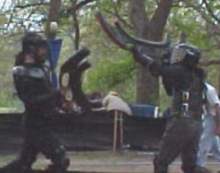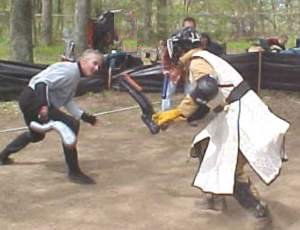Batleth Tournament Operations
800*600
This is the Academy of the IKV Melota.
This is where you will find useful information on HOW TO to many of the things that we assume are regular processes for our ship.

This was originally written in 2002 and has some updates inserted. Thus the Tenses and Continuity on some points may become disjointed.
An email shortly after the Fall 2005 Tournament:
I must admit though: The psychological feel of combat vs.
weekly practice takes a bit of getting used to...
Dragen
The Reply on the List:
The adrenaline rush. The is a considerable difference between a friendly backyard practice and standing in the ring seeing your reflection in the eye of an opponent.
K'Mok
This paper from www.janissaries.net is to describe the operations of a Batleth Tournament. This paper assumes that you have read and PRACTICED the information supplied in "Batleth Basic Concepts" and "Batleth Practice Concepts".
The Tournament concept that we use in the DFW area and its original Rules were devised in 1999. The Rules are still in the process of evolution as we all learn from each additional Tournament. This document reflects those original Rules and some of the lastest evolutionary changes.
Tournament for us is a more formal affair with a different set of rules. It is an artificial environment unlike the freestyle, "real world" operations of the Batleth Practice. This paper will break the differences down as follows:
the Main Difference
the Classes
the Ring
the Rules
the Judges
the Scorekeeping
the Scoring
The Main Difference:
This is artificial and not real world. In the beginning of our Batleth Practice and Tournaments, we had some less honorable Warriors who would be "immortal". They would not accept their "wounds" and "deaths". Thus the artificial premise of the Tournament is to insure that hits are counted and "immortal" warrior will "die". At the time of this writing, we have eliminated most of the "immortals". However, it is now tradition that this is an externally Judged competition instead of an "on your honor" competition. The Tournament follows the basic rule that if the Judges do not see the hit, it did not take place. Likewise, if the Judges call a hit, it did take place. The fighters will continue the fight even if they make known contact until the Judges yell, "Break!". In reality, the Judges do not always see proper hits, and sometimes believe a hit took place that was truly a miss. (Think of baseball, here.) It is not perfect. But it generally works out as fair if you accept that you can win or lose based upon a bad call. The object is to have FUN. Don't argue, accept the scoring good or bad. But overall, the errors tend to cancel themselves out.
the Classes:
Currently there are four Classes of competition and these are based upon the weapon. We make no distinction, nor do we grant privilages to ages, weights, or genders. If a person is willing to step into the Ring to fight, then they are a Warrior regardless of their size, age, or personal equipment.
Batleth- This is real obvious. A single Batleth against a single Batleth.

MeQleth- This traditionally has only been single MeQleth against single MeQleth. As of our Spring 2002 Tournament, it has been opened to dual MeQleth against dual MeQleth. The priviso is that the Warriors are each given a choice of single or double and that the Lowest Common Denominator prevails. K'blam wants doubles. M'rek wants single. Single will always prevail and they shall fight single to single. The odd provision is for the Warrior who willingly chooses to take a single MeQleth against a dual opponent. The provision here is that that Warrior is asked 3 times to confirm their choice. Once confirmed, they lose all "Griping Rights" if they lose. They can keep the "Bragging Rights" if they win.

DaQ'tag - This was instituted Spring 2001. It was single DaQ'tag against single DaQ'tag until Spring 2002. Then the same single-single / dual-dual Rules were instituted. Another exception to the normal Rules and Judging process arises with DaQ'tags. They are so fast and personal that the Combatants MUST call their own wounds/deaths.* The Judges attempt to continue their function, but the Combatants MUST assist the Judges with "on your Honor" announcements of incoming hits. This is where having eliminated "immortals" allows another form of competition. "Immortals" would quickly wreck the fun of this Class. It is fast, brutal and must have the Honor of the Warrior. The nature of the fighting is such that it is not unusual to see "10 to 10" scores to settle a 3 point fight. The record at this time was a 17 to 17 bout to settle a 3 point fight.
* As of 2004, a twist was added that later in 2005 became design. In 2004, those brave enough to cling to our keltic heritage wore loinclothes into the ring. We also painted the blades. The thought was that by not wearing clothing, we did not care about losing those clothes to the paint. The loinclothes were a concession to a) the spectators present, and b) the Internet. Otherwise, knowing that our ancestors fought wearing only woad, we would have done so. Our keltic forefathers wore only woad into battle. We would have fought in that manner except for those two aforementioned American prudish concerns. The paint strikes made judging easier as the paint told the truth of the strike. The original reasoning was that we were not wearing clothes that could be damaged by paint thus we painted our blades. By 2005, combatants were asked to wear disposable white Tshirts if they were not able to go shirtless. By 2006, disposable Tshirts were being issued to Warriors of either gender by the IKV Melota in order to allow the paint to tell the tale of combat.

Freestyle - This is Combat with any combination of any accepted weapon(s). Normally legally accepted Freestyle weapons are used in this Class, however, klingon weapons are certainly acceptable. This is where combinations such as Batleth+MeQleth are pitted against hammer+shield.

Melee - This is a discontinued class. It was a total free-for-all of all Combatants at the same time. The problems arose in that the Ring was not large enough and there were not enough Judges available to cover 16 Warriors in simultaneous Combat. The "was-it-seen factor" heavily outweighed the skill factor and thus the scoring was not fair. It could be considered as a fun "on your Honor" Combat item but not for scoring purposes. With the addition of the DaQ'tag competition, we also did not have enough time in the day to do all of the Classes so this Class was a casualty.
ShipONship - This is a discontinued class. It was an matching number of Warriors from two ships pitted against each other fighting for their respective ship. With 2 ships, it was a quick Class. However, it does require having enough regular Warriors to support a Team. As time went by, our competitors dwindling to only 2 Warriors on a Team just did not cut the mustard. Since the IKV Melota was the only ship in the area capable of supporting a Team of 5, this class was discontinued. Now, the DaQtag has taken the place of this Class.
This Class is where Team Combat practice, or a failure to do so will really be obvious. If a ship does not practice Team Combat then that ship's Warriors will either fight as individuals and fall before a coordinated Team, or they will become fratricidal through lack of experience. Properly trained Teams should provide an exciting Combat with various Team techniques applied. This kind of Combat actually brings in the study of discipline, leadership, and technique. As two Teams fight there can be different approaches to Combat. Member assignments and Team discipline can dramatically affect the efficiency of the Team.
the Ring:
The Ring was originally a cleared circle, 20 feet in diameter. It had two 3x3 boxes on opposite sides for the Combatants to start from. This has been the traditional Ring. The Ring is racked and cleared of stones, twigs and junk, and is clearly marked with paint. During the Tournament, the paint markings are replaced as necessary. The issues we found were twofold. There was casual traffic of animals, children and Warriors across the Combat Zone that interfered with operations. Also, having a small Ring, larger Warriors had the advantage of Sumo wrestling smaller Warriors for a "Ringout". Smaller Warriors had no real room to manuever. The sponsor of the Spring 2002 Tournament opted to use a 30 foot diameter Ring (without start boxes). This was surrounded by a 3 foot high fenceline outside of a 5 foot buffer zone. This accomplished the goal of having plenty of Combat room, plus room for "Ringouts" before hitting the fenceline. It kept animals and children (is there a difference?) out of the Ring. It also dramatically cut down on nonCombatants casually wandering into the Combat Zone. As a smaller Warrior, I believe that it truly did help level the playing field when fighting against larger Warriors.

As to Rings, Spring 2003 brought a new twist. The Triskel was introduced as the "Ring". This larger "Ring" required twice the fencing, but produced some decididly different approaches in the "Ring". You can bet your Quatloos that this was much harder to fight within. Especially for the smaller Warriors. If a larger Warrior took control of the center, then the smaller Warrior only had a 120 degree corner to work from. With this "Ring" type, it is VITAL to have each combatant to return to a corner so that the combat does not open with somebody already controlling the center.
Some Tournaments had twin Rings operating simultaneously to clear the number of bouts. On a high registration Tournament, you may find it necessary to add a second Ring. In our earlier days with lessor organization and a high turnout, we ran twin Rings. The preparation and organization of the later years has returned the Melota to a single Ring. We would dearly love to have enough participants to force our Tournament to become a three Ring "circus".
the Rules:
The Rules are fairly simple and intended to keep the Tournament safe, fun, and to operate relatively smoothly.
1 Judges are always right.
2 No swings that break the plane of the shoulders.
3 Head shots are grounds for immediate expulsion.
4 Accidental illegal shots do not score points.
5 No arguing with the Judges or Scorekeeper.
6 If in doubt, see Rule #1.
the Judges:
The Judges consists of a Team of 3 for each bout. Each Judging Team consists of a Head Judge and two assistants. The object is to have 2 Judges assigned to the Combatant's weapon(s), with each assistant Judge concentrating on one Combatant's weapon(s). The third Judge watches the overall Combat. Theoretically this arrangement should see all of the contacts. When a contact is made, Ringout, or a safety issue arises, the observing Judge will yell, "Break!". Hostilities are IMMEDIATELY stopped. Combatants separate and the Judges can then hash out what they saw or resolve the safety issue. In Judging proper, only Judges have the authority to yell "Break". In matters of safety, all present, Combatants, nonCombatants, ANYBODY, have the authority to call a Break for the sake of a safety issue. This is usually when a weapon breaks but not in a manner that the Combatants can see during the fight.
As you can imagine, or see from the videos, like in Baseball, there are bad calls that are simply going to happen. Live with them, they average out unless you have a biased Judging Team. It is incumbent upon the Judges to move about the Ring to maintain sight of the weapons. Only the Head Judge can tell the Scorekeeper the points scored for each action. This keeps a single point of contact for the Scorekeeper to reduce confusion. They all three Judge equally, compare what they saw and decide the points to be awarded for each action. But only the Head Judge transmits this to the Scorekeeper.
Judges are Armed Observers!

Note the ARMED judges in the background.
Ignore the Bloodwine mug, though.
Judges should be armed while judging to fend off accidental hits due to their necessarily close proximity to the Combat. They also should keep in mind the videocameras and attempt (within reason) to avoid blocking the videocamera recording the event. An alert, competant, and caring judge will make an effort to avoid masking the camera while performing his duty to the Ring.
It is necessary to have spare Judges and possibly spare Judging Teams. If two Rings are used, then obviously a minimum of six Judges is needed. Spares are required for when one of the Judges themselves enter the Ring as a Combatant. Optimally, a full time, NON-Combatant Judging staff would be best. If SCA, Amtgard or other competant personnel can be found that do not wish to fight, they would be perfect for a full time Judge.
the Scorekeeping:
This is a very important position requiring an attentive person. This is perfect for a Warrior that must sit out the Tournament for medical reasons, but wants to contribute. The Scorekeeper registers the Combatants at the beginning of the Tournament, sets up the scoring trees, and records the points as they are called off by the Head Judge. The Scorekeeper must keep track of who is Head Judge each bout in case of substitutes for they must only accept scores from the Head Judge. Ultimately, the Scorekeeper adds up the scores to determine the final outcome of the Tournament. It is highly recommended that there be one Scorekeeper per Ring, and that they stay with the Ring for the entire Tournament. Avoid substituting or changing Scorekeepers, period. It leads to confusion. Confusion leads to anger. Anger leads to hate. And hate leads to suffering.
the Scoring:
Each bout is a 3 point bout. The winner is awarded the difference between his score and the opponent. Thus a skunk gets 3 points, but a 3:2.5 win only gains a half point for the effort. These points are accumulated to determine the final rankings. This may sound awkward. But it has its advantages. For older and slower Warriors such as myself, this system allows us an incentive to continue playing even though we normally lose. Constant loses can be demoralizing leading to a Warrior quitting. For those of us with strong Wills, we can pursue the goal of wrecking a Champion's Points Spread. This is the incentive and game for those of us who will lose regularly. I don't fight to win. I fight to trash my opponent's Point Spread. I will lose. But you will suffer dearly to gain nothing. This is an offshoot of the Team Warfare theory of a sacrificial Warrior tying up multiple opponents for the sack of his Team. With this in mind, weaker and slower Warriors can fight valiantly for their Ship's total score by wrecking the opposing Ship's total score.
The traditional scoring method was a subjective ranking system of one-half point for a "wounding" blow and a full point for a "killing" blow. These scores were awarded regardless of torso or limb as target. Illegal hits are denied points.
Disarming an opponent is worth a point. This is usually knocking a weapon out of your opponents hand, but can include simply taking possession of his weapon.
If a Warrior gets both feet outside of the Combat Ring, it is a "Ringout" and a half point is awarded to his opponent. Spring 2002, one foot was sufficient, and this was easier to Judge. The final winning point can NOT be a Ringout. This precludes larger Warriors winning by Sumo techniques. At least their last half point must be a blade even if the other 2.5 can be pushing.
The Spring 2002 Tournament saw the Rules changed to half point for limbs, full point for torso, Period. This really helped to take the subjective factor out of some of the scoring. Some Judges tend to count all as a full point and if the Judging is less than impartial, this is an area to favor one Warrior/Ship over another.
Each Warrior's points are totalled to count towards the awards.
Awards generally presented are
First Place for each Class Batleth, MeQleth, DaQ'tag, Freestyle.
Win, Place, Show for the Tournament Overall.
It is totally possible through the math matrix to have a Warrior not win a single Class but still Win/Place/Show in the Overall.
The best example in application of this text would be to watch some of the videos available at www.janissaries.net. As of Summer 2002, there have been "HOW TO" specific videos available for downloading. Also, the longer Combat videos will allow you to watch for operation techniques.
Hom Salek Sutai
Ship's Brewer
Commo Officer IKV Melota
www.janissaries.net

Ceremonies Concepts
Academy
Video Downloads Page
Home
The IKV Melota is a non-profit organization supporting Mr. Roddenberry's vision of the future. We find it very distressing that Viacom and Paramount do not share his visions. We recognize all trademarks and copyrights as belonging to their owners and hope that the owners have sense enough to realize that we fans pay the bills. There is no need outside of testosterone and rectal attitudes to pursue fan sites.
Given that this is not a commercial venture, as webmaster, I partake of the KISS principle and shall have a very simple site. Simplicity is beauty, like the curve of the Ba'Leth.








